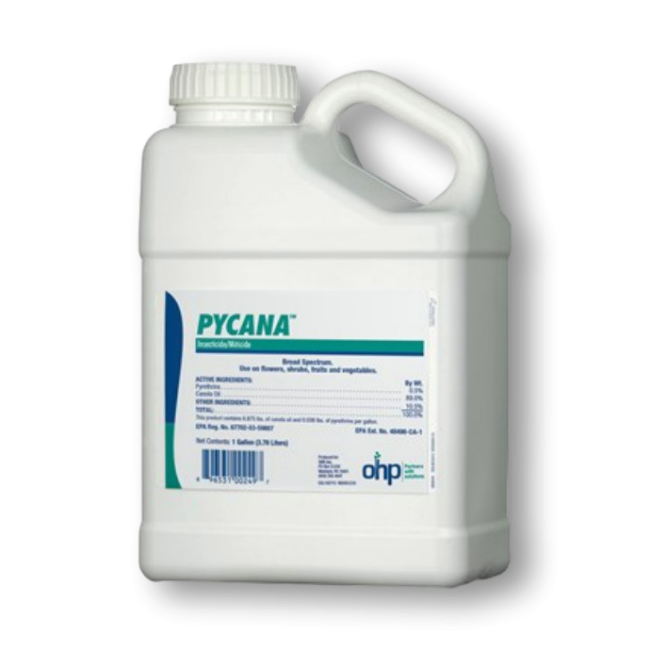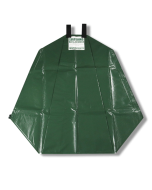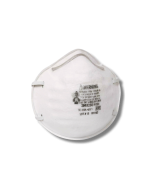Gain access to personalized product screening, the best pricing, rewards, and more!
OHP Pycana
OHP Pycana is a fast-acting and powerful botanical insecticide and miticide that provides effective contact control of soft-bodied insects and mites on ornamental plants and vegetables in greenhouses, shadehouses, nurseries, and nursery crops.
12/30/25
OHP Pycana, manufactured by OHP, is a reliable OMRI-listed insecticide and miticide that delivers quick knockdown and control of all life stages of insect and mite pests, with zero preharvest interval, no residual impact on beneficials, and a strong fit for IPM programs on ornamentals, herbs, and vegetables.
This dual-action product creates a one-two punch: pyrethrins for fast knockdown and canola oil for smothering and lasting suppression of eggs, larvae, and adults of mites, caterpillars, whiteflies, Japanese beetles, and more. A huge advantage of OHP Pycana is that it can be used up to the day of harvest, which enables growers under increasing demand to implement pest control when needed without halting production.
OHP Pycana is a natural insecticide and miticide that provides flower, shrub, fruit, and vegetable growers a quick pest control in organic sites. For growers facing constant pest pressure in sensitive production systems, this product offers a dependable solution without the baggage of conventional insecticides.
Tools Needed
A boom sprayer, handheld pump sprayer, backpack sprayer, airblast sprayer, or spray rig can be used.
How to Use
- Step 1: Determine how much OHP Pycana to use by measuring the square footage of the treatment area. Find the square footage by measuring the treatment area's length and width in feet, then multiply them together (length X width = square footage). For acreage, take the square footage and divide it by one acre (square footage / 43,560 sq. ft. = acres). For flowering, foliage, and bedding plants apply 1.5 to 3 gallons per 1,000 sq. ft. For 2% solution, mix 2 parts concentrate with 98 parts water. For 1% solution, mix 1 part concentrate with 99 parts water. Refer to the product label for specific application rates and restrictions.
- Step 2: Fill the sprayer tank with half the amount of water, add the proper amount of product, and pour in the remaining half of the water. Close the tank lid and shake well until mixed.
- Step 3: Spray the top and bottom of the foliage leaves until wet, but not to the point of runoff. Do not apply more than 1 time per day. Do not reapply within 3 days except under extreme pest pressure.
Where to Use
OHP Pycana can be used on flowers, shrubs, fruits, and vegetables.
When to Use
Make applications when pests are first noticed on days when temperatures are not above 90 degrees Fahrenheit.
May be used on edible crops up to and including the day of harvest.
Do not harvest until the spray has dried.
Safety Information
OHP Pycana is safe for people and pets when applied according to the product label instructions. Always wear the proper personal protective equipment (PPE) when mixing and applying this product.
Keep people and pets out of the treated area until the spray has dried.
Special Considerations
Do not apply within 21 days of a sulfur application.
Use a 1% solution on oil sensitive plants such as: Chamaecyparis, Cryptomeria, Japanese Holly, Red Cedar and Smoke Tree. Use care on blooms and buds.
| Restricted Use | No |
|---|---|
| Shipping Restrictions | AR, ID, IN, MN, MS, NC, VT, WI |
| Availability | Online |
| Signal Word | CAUTION |
| Keith's Pro Tip | "Use care on blooms and buds. If concerned about sensitivity of plants, test spray a portion of the plant and wait several days to determine if burn occurs before spraying larger areas." |
| Time to Kill | OHP Pycana will kill pests within several days. |
| Chemical Type | Insecticide |
| Formulation | Emulsifiable Concentrate (EC) |
| Application Methods | Broadcast Spray |
| Product Drawbacks | Oil removes the glaucous (blue) bloom from such evergreens as Colorado Blue Spruce and Koster Spruce. |
| Active Ingredient | Pyrethrins 0.5% Canola Oil 89.0% |
| Application Equipment | Backpack Sprayer, Hose End Sprayer, Pump Sprayer, Spray Rig |
| Mix Rate | For flowering, foliage, and bedding plants apply 1.5 to 3 gallons per 1,000 sq. ft. For 2% solution, mix 2 parts concentrate with 98 parts water. For 1% solution, mix 1 part concentrate with 99 parts water. |
| Use Sites | Outdoors |
| Yield | Coverage will vary. |
| EPA Registration No. | 67702-53-59807 |
| Shelf Life | OHP Pycana will last for 3 years when stored in a dry, clean area. |
| Comparable Products | TYVET PRO Essential Oil Insecticide |
| Children or pets? | No |
| Property Characteristics | None |
| Availability | Online |
| Restricted Use | No |
| Brand | OHP |
| Keith's Pro Tips | "Use care on blooms and buds. If concerned about sensitivity of plants, test spray a portion of the plant and wait several days to determine if burn occurs before spraying larger areas." |
| Product Drawbacks | Oil removes the glaucous (blue) bloom from such evergreens as Colorado Blue Spruce and Koster Spruce. |
| Target Pests | Adelgids, Ants (including Acrobat Ants, Argentine Ants, Bigheaded Ants, Cornfield Ants, Crazy Ants, Field Ants, Foraging Ants, Ghost Ants, Little Black Ants, Moisture Ants, Odorous House Ants, Pavement Ants, Sweet-Feeding Ants, Texas Leafcutting Ants, Thief Ants, and other Common Ants, except Carpenter Ants, Fire Ants, Harvester Ants, and Pharaoh Ants), Aphids (including Cotton Aphids, Green Peach Aphids, Melon Aphid, and Wooly Aphid), Armyworms (including Beet Armyworms, Fall Armyworms, Southern Armyworm, and Western Yellow Striped Armyworms), Bagworms, Beetles (Asparagus Beetle, Bean Beetles, Blister Beetles, Colorado Potato Beetle, 12-Spotted Cucumber Beetles, Cucumber Beetle, Darkling Beetles [Lesser Mealworm], Elm Leaf Beetles, Flea Beetle, Japanese Beetle, Mexican Bean Beetles, Saw-toothed Grain Beetles, and Western Striped Cucumber Beetle), Borers (including Branch and Twig Borers, European Corn Borer, Dogwood Borer, Pacific Flathead Borers, Peach Twig Borer, Shot Hole Borers, and Squash Vine Borer), Box Elder Bugs, Cabbageworms (including Cross-striped Cabbageworm and Imported Cabbageworm), Cankerworms, Caterpillars (Eastern Tent Caterpillar, Forest Tent Caterpillar, Gypsy Moth Caterpillars, Tent Caterpillar, and Tomato Fruitworm Caterpillar), Corn Earworms, Crane Flies, Crickets, Diamondback Moth Larvae, Earwigs, Fireworms, Fruit Flies (including Cherry Fruit Fly), Fungus Gnats, Glassy Winged Sharpshooter, Grape Leaf Skeletonizer, Grasshoppers, Green Fruit Worm, Harlequin Bugs, Hornworms (including Tomato Hornworm), Katydids, Lace Bugs, Leafhoppers (including Grape Leafhopper and Potato Leafhoppers), Leaf Miners (including Chrysanthemum Leaf Miners, Citrus Leaf Miners, Tentiform Leaf Miners), Leafrollers (including Fruit Tree Leafrollers), Leaftiers, Loopers (including Cabbage Looper), Lygus, Maggots (including Apple Maggot, Cabbage Maggots, and Onion Maggot), Mealybugs (including Citrus Mealybugs, Grape Mealybugs, Longtail Mealybugs, Madeira Mealybugs, Obscure Mealybugs, Pink Hibiscus Mealybugs, and Vine Mealybugs), Millipedes, Mites (including Clover Mites, European Red Mite, and Spider Mites), Moths (including Artichoke Plume Moth, Codling Moth, Diamondback Moth, European Pine Tip Moth, Gypsy Moths, Indian Meal Moth, Oriental Fruit Moth, and Mediterranean Flour Moth), Mushroom Flies, Navel Orangeworm, Non-biting Midges, Phylloxera and Powdery Mildew, Plant Bugs (including Leaf-footed Plant Bug, Mullein Plant Bugs, and Tarnished Plant Bug), Psyllids (including Asian Citrus Psyllids and Pear Psyllids), Sawfly Larvae (Pear and Rose Slugs), Scale Insects (including Armoured Scale, Asian Cycad Scale, California Red Scale, Caribbean Black Scale, Citricola Scale, Cottony Maple Scale, Euonymus Scale, Fletcher Scale, Florida Wax Scale, Green Shield Scale, Indian Wax Scale, Oyster Shell Scale, Pine Needle Scale, Red Scale, San Jose Scale, Soft Scale, and Tea Scale), Silverfish, Skippers, Sowbugs, Spittlebugs, Squash Bugs, Stink Bugs (including Brown Marmorated Stink Bug), Thrips (including Citrus Thrips, Cotton Thrips, Greenhouse Thrips, Palm Thrips, and Western Flower Thrips), Vinegar Flies, Webworms, Weevils (including Black Vine Weevil, Boll Weevil, Carrot Weevil, Clover Weevil, Pecan Weevil, Pepper Weevil, Plum Curculio Weevil, Rice Weevil, and Strawberry Weevil), Whitefly (including Banded Whitefly, Giant Whitefly, Greenhouse Whitefly, Silverleaf Whitefly, and Sweet Potato Whitefly). |
| Application Equipment | Backpack Sprayer, Hose End Sprayer, Pump Sprayer, Spray Rig |
| Application Methods | Broadcast Spray |
| Active Ingredient | Pyrethrins 0.5% Canola Oil 89.0% |
| Product Type | Insecticide |
| Formulation | Emulsifiable Concentrate (EC) |
| Application Rate | For flowering, foliage, and bedding plants apply 1.5 to 3 gallons per 1,000 sq. ft. For 2% solution, mix 2 parts concentrate with 98 parts water. For 1% solution, mix 1 part concentrate with 99 parts water. |
| Shelf Life | OHP Pycana will last for 3 years when stored in a dry, clean area. |
| Yield | Coverage will vary. |
| Use Sites | Outdoors |
| Time to Kill | OHP Pycana will kill pests within several days. |
| Comparable Products | TYVET PRO Essential Oil Insecticide |
| Incompatible Home Siding | Brick, Hardie Plank, Stone Veneer, Stucco, Wood, Vinyl |
| EPA Registration # | 67702-53-59807 |
*Price does not include freight. We guarantee our rate plus shipping will be less than anyone else's price.














